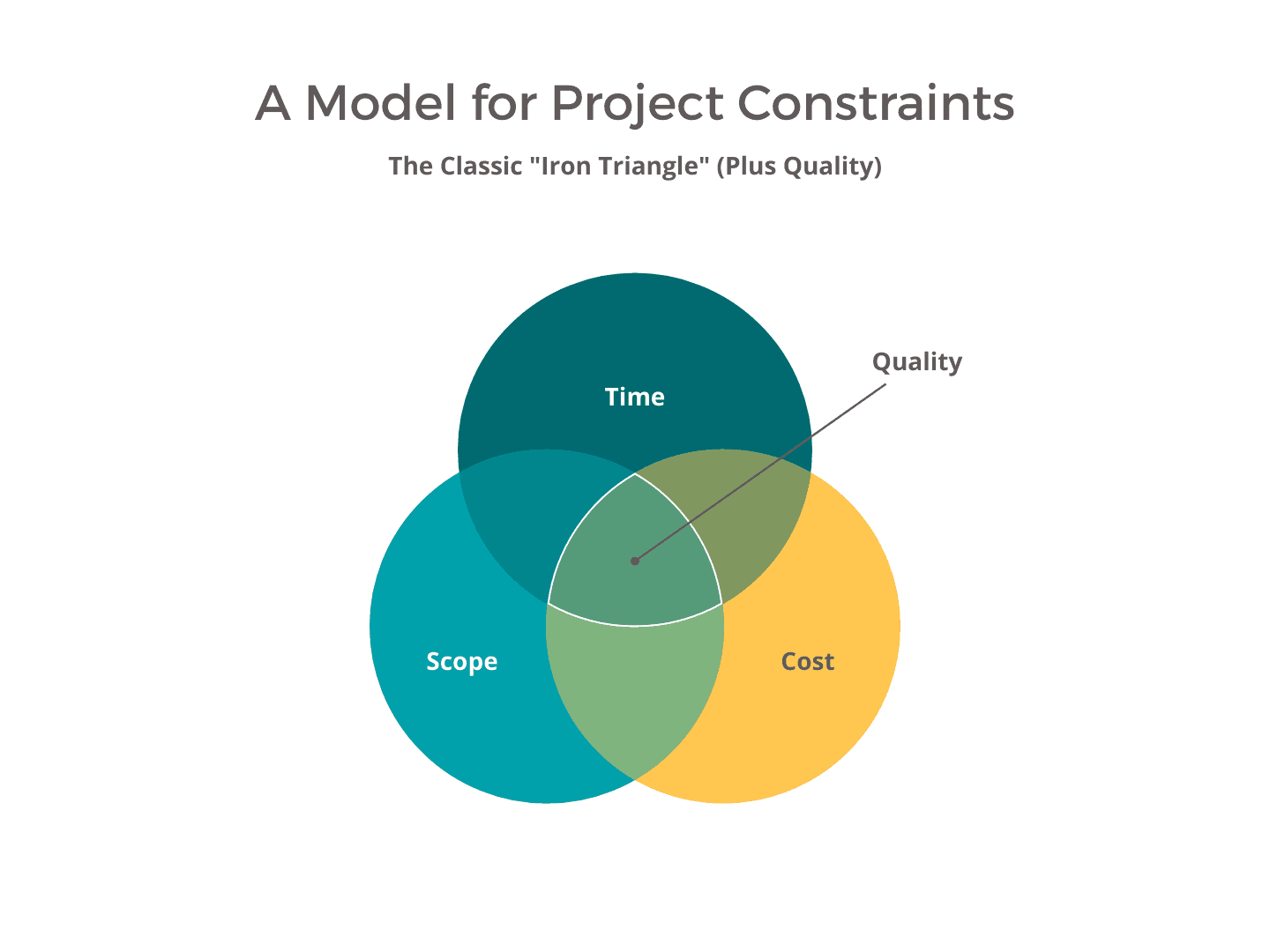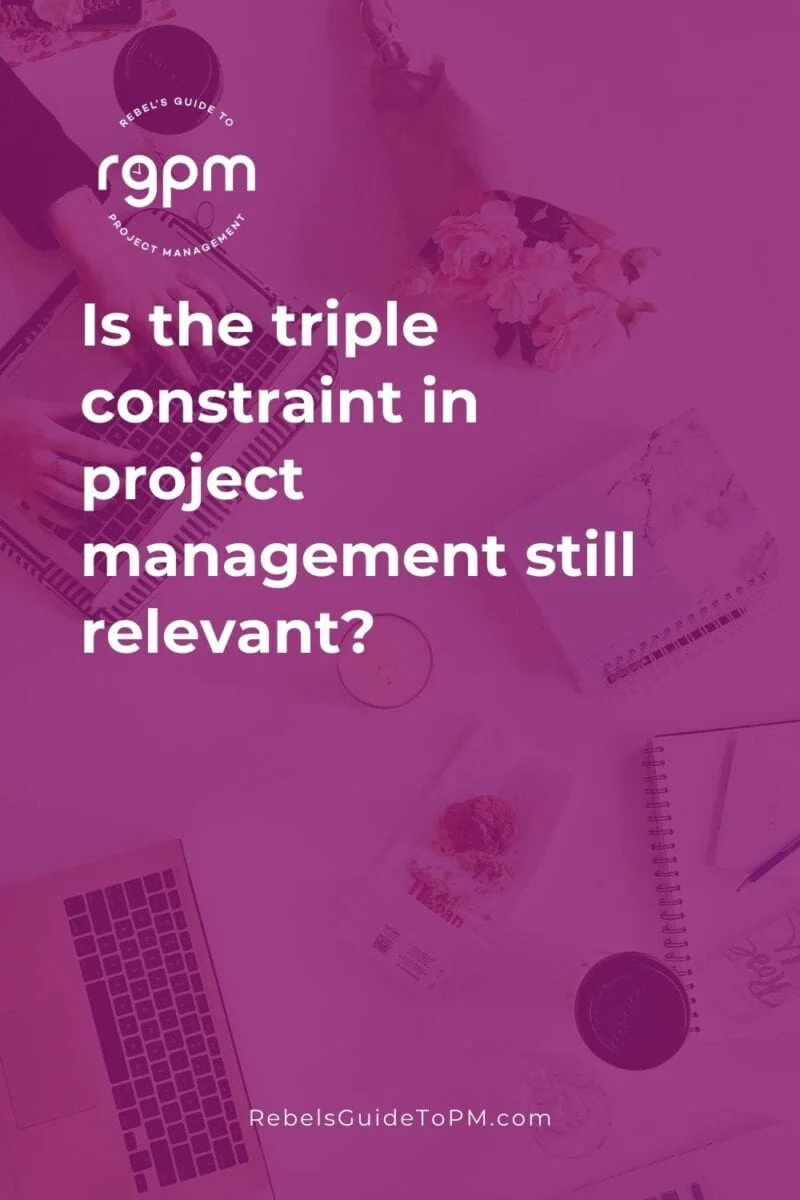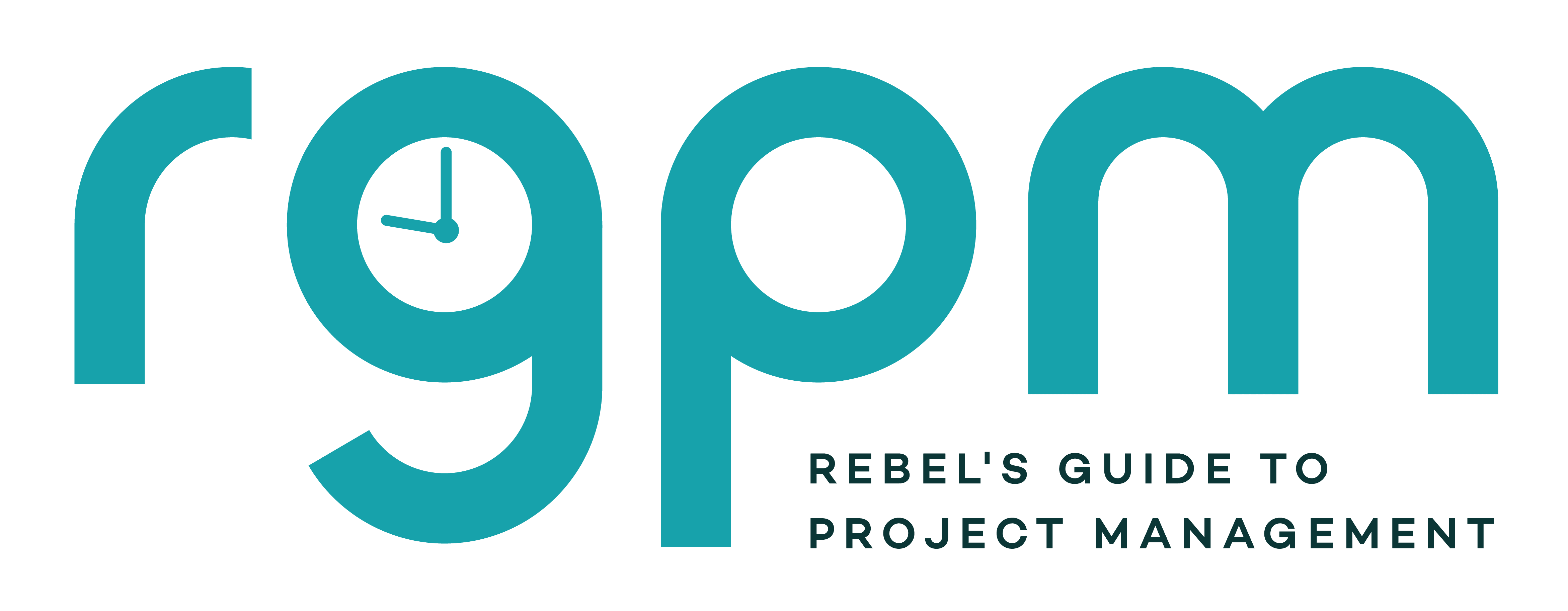Is the triple constraint in project management still relevant? (Spoiler: No!)
Projects always have certain constraints – there may be an urgency to complete a project because of external market factors, for example; or there may have to be tightly controlled costs because of a fixed or limited budget.
The project will also be expected to deliver on certain expectations including quality levels.
What is the Triple Constraint?
The most commonly used planning constraint method in project management was historically the “triple constraint” – time, cost and scope – sometimes known as the project management triangle or the “iron triangle” because it’s often shown as a triangle with the constraints at each vertex.
You get a glimpse of Martin Barnes, inventor of the Iron Triangle, in this video on the history of project management.
Alternatively, you may see it represented as 3 inter-locking circles with Quality at the center.

But even including quality as one of the triple constraints in project management omits other constraints that have proved to be equally important.
Factors such as risks, resources (human and otherwise), expectations or even R&D or technology issues for ground-breaking tech projects can be considered as constraints.
Since managing project constraints is such a major part of effective project management, many practitioners have expanded the constraints model to a diamond shape to include Quality as a key constraint.
It has been increasingly recognized that even this does not go far enough and a 6-pointed (or more) star is proving to be a more realistic constraint model for today’s projects.
The 6 project constraints are time, cost, scope (as per the triangle) and then quality, risk and resources.
Time
Time constrained projects have fixed deadlines or resources that are only available for a certain time. Perhaps the project has to be completed by the end of the financial year or (worse) the execs have already announced it to clients and now you have to deliver to the dates that have been promised.
Manage your project schedule carefully to stay on track.
Cost
Many projects have fixed or maximum budgets that cannot be exceeded. A cost constraint can be really difficult to manage for a project where the other constraints are not controlled, so watch out for that.
Scope
Scope is a constraint as the more you add into project scope, the longer the work takes and the more it costs. You can only deliver the scope items that you can afford.
Scope constraints are things like only rolling out the solution to some offices, developing certain features and pushing some into the backlog and choosing the features that you can afford.
Manage scope creep carefully to stay on top of this.
Quality
If you’re building an aircraft, quality has to be a top priority! If you’re doing a school science project, maybe quality of deliverables isn’t the most important thing and you can afford a few rough edges.
Quality is typically constrained by how much money you’ve got — if you can throw money at a solution (and time) you have the opportunity to increase quality.
Risk
Some projects are constrained by the amount of risk that the organization is willing to take. Going live with innovative new solutions? Maybe you can afford a high risk strategy with a small friendly pilot group.
Project risks are something you should be managing anyway as a project leader, so make sure you are escalating major risks to the program or portfolio level. Then aggregated risk can be managed across the organization.
Resources
Resource constraints are, in my experience, the most common. If you can throw resources at a problem, you can often solve it faster or get the solution delivered faster (not always though).
Resources cost money, whether it’s people, materials, software licencing or other types of resources, so this constraint is tightly related to cost.
Honestly, projects today are constrained by a lot of things so let’s not be constrained by an arbitrary list of 3 or 6 items. You could also add in sustainability, or anything else that makes sense for your project. Use those as a starting point and build from there.
Why are project constraints important?
Whatever shaped constraint model you choose to use and whatever constraints are deemed most important for any particular project, what is always true is that if one constraint is adjusted it will undeniably have an effect on the others.
So if you have taken the simplistic approach that there are only three common constraints – Time, Cost and Scope – and you increase the scope of the project then it is fairly obvious that this will impact the amount of time taken to complete the project and/or the project budget.
Equally, once you introduce Risks, Resources and Quality to the mix then changing just the scope again impacts quality, potentially introduces more risk and can also impact on resources.
It is balancing all of the constraints that is important to delivering a successful project – it’s not rocket science but continues to be a challenge on many projects.
Read next: 5 Steps for Identifying Project Constraints and Dependencies
The problem with the traditional triple constraint in project management
It may still be possible to manage a project and deliver it successfully using the three simple constraints of time, cost and scope. Possible maybe on a simple project of a type in which the project manager and project team have previous experience, in which the costs are well understood and the scope is clear-cut.
However, once you introduce an element of the unknown or a new team or project manager even simple projects can face difficulties with this model.
Introduce some complexity and then risks, resources, quality and expectations all become major influences over the success of the project and the triple constraint model can prove to be lacking.
As with so many other elements of project management, the models and methodologies provide a sound base from which to develop a more tailored approach for a particular project and its circumstances.

Different constraints for different projects
Although most PM practitioners broadly agree on the important constraints in any given project, the details of the constraints will naturally vary from project to project as will their importance to the stakeholders.
Some customers or stakeholders might be prepared to be flexible with the budget if they ultimately get what they want, whereas other customers may be prepared to compromise on the deliverables in order to stay within budget.
There is rarely a project where some form of compromise is not acceptable and many businesses with long experience of projects will know to expect compromises along the way.
An old boss of mine used to say that if the client was 100% satisfied then we had spent too much money, time and effort on the project (but I won’t tell you who that was…).
For a project manager, then, it is important to understand the finer details of each constraint on each project and to manage accordingly.
Customer expectation is perhaps one of the most difficult constraints to get right not just because expectations vary from customer to customer but because they might also vary between individual stakeholders – and can be hard to measure and clearly define.
Read next: 10 Quick Tips for Being More Customer-Centric on Your Projects
The impact of changing constraints
Managing constraints on any project is about balancing each of them to deliver a successful outcome. Any changes will impact other areas of the project and this should be made clear to all stakeholders at the outset – the big question is really how and by how much will change impact the end result.
Changes cannot be overcome by throwing people and money at a project, even if you have the resources and the money – beware of thinking they can. Extra cash and resources can simply put pressure on other areas such as dependencies, not to mention the additional management time required.
The classic project management triangle with the three core constraints of time, cost and scope is still relevant but perhaps limited in its approach. It is certainly still a useful tool to focus priorities when making high-level decisions about how to best balance these constraints for a successful outcome.
What do you think? Connect with us on LinkedIn to share your thoughts.
